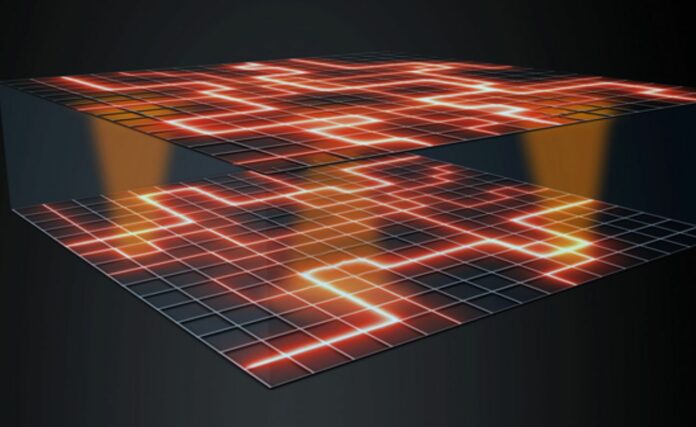The breakthrough study sets a new standard for the manifestation of the interdependent networks theory in a physics laboratory, unlocking opportunities for further development and control of complex, multiscale phenomena in interdependent materials.
Back in 2010, Prof. Shlomo Havlin and his collaborators made a significant breakthrough with their work in the prestigious journal Nature. Their article put forth a groundbreaking proposition: the 2003 Italy blackout, characterized by an abrupt electricity failure, was a direct consequence of the interdependency between two networks.
According to Havlin’s theory, the interconnection of the power network and its communication system set the stage for cascading failures and an eventual sudden collapse.
This seminal work by Havlin and his team sparked a new field in statistical physics known as “network of networks” or “interdependent networks,” revolutionizing our ability to understand and predict the intricate effects of network interactions.
At the heart of Havlin’s model lies its main novelty—the recognition of two distinct types of links that embody qualitatively different forms of interaction. Within networks, the links between nodes represent connectivity elements, such as electric power or communication connections.
However, between networks, the links reflect dependency relationships, where the functionality of a node in one network relies on the functionality of a node in the other. This interdependence becomes evident when considering that communication hubs rely on a continuous supply of electricity, while electric power stations depend on effective communication control.
Consequently, the failure of a single node in either network has the potential to trigger a cascading effect, resulting in an abrupt breakdown of both interconnected networks.
In the past decade, Professor Havlin from the Department of Physics at Bar-Ilan University in Israel, along with other researchers, has applied the concept of interdependent networks to various abstract systems such as the internet, road traffic, the economy, and infrastructure. However, as a theorist, Havlin faced limitations in confirming the theory through controlled experiments or implementing it for device-type applications using real experimental physical systems.
To overcome these limitations, Havlin collaborated with Professor Aviad Frydman, an experimentalist specializing in electrical properties of disordered systems, particularly superconductors, in the Physics department at Bar-Ilan University. Superconductivity is a phenomenon observed in certain metals where electrical resistance completely disappears below a critical temperature when cooled.
This collaboration allowed Havlin and Frydman to bridge the gap between theory and experimentation, enabling them to explore the manifestation of interdependent networks on real experimental physical systems, which was previously unfeasible.
Drawing inspiration from Havlin’s theory, Frydman’s research group devised a meticulously controlled setup of interdependent superconducting networks that served as a physical representation of the interdependent networks involved in the Italy blackout.
In this system, two superconducting networks were placed in proximity but separated by an electric insulator layer. Interestingly, this layer facilitated the transfer of heat between the networks, thereby establishing two distinct types of interactions within the system.
While the electric currents within each network mirrored connectivity links, the heat flowing between the networks symbolized dependency links, capable of disrupting the superconductivity segments.
The collaborative efforts of Havlin and Frydman brought together a team that included lab manager Dr. Ira Volotsenko and three accomplished graduate students: Dr. Ivan Bonamassa, Bnaya Gross, and Maayan Laav.
The recent research, published in Nature Physics, demonstrates that linked networks exhibit a discontinuous transition from superconductor to normal metal, in contrast to uncoupled networks that exhibit a smooth, continuous transition. This is due to the current flowing in a normal segment of one layer causing a superposed segment in the other layer to become hotter, leading to a loss of its superconductivity.
As a result, the thermal feedback process between the layers self-propagates, resulting in an avalanche of junctions entering the metallic phase. The study’s significance lies in establishing the first physics laboratory benchmark for the manifestation of the interdependent networks theory, which can aid in controlling and advancing the multiscale phenomena of complex interdependent materials.
This research holds immense significance across various disciplines, including basic physics, materials science, and device applications. In the realm of basic physics, its scientific impact lies in the revelation of new phenomena pertaining to phase transitions.
The findings challenge the long-held notion that phase transitions governed by a single interaction type, which have been extensively studied for over a century, represent only a narrow scope. Instead, they unveil a much broader and richer spectrum of phenomena governed by multiple types of interactions.
Furthermore, these results have the potential to pave the way for the establishment of an entirely new field: network metamaterials. This emerging discipline would revolve around coupled layers with distinct inter-layer interactions, giving rise to novel physics phenomena. Moreover, the research suggests that the abrupt breakdown of network systems can be a desirable phenomenon. Harnessing this phenomenon could have significant applications in engineering self-healing systems, designing highly sensitive switchers or sensors, such as those utilized in single-photon detection.
Interestingly, while network science originated from physics in 2000, its subsequent advancements and applications have predominantly benefitted other scientific and technological domains rather than physics itself. However, this study serves as a remarkable reconnection between network science and physics.
It demonstrates that the innovative concepts derived from network science can substantially contribute to physics, leading to the discovery of novel physical processes, including previously unexplored types of phase transitions, particularly in the context of interdependent physical systems.
Source: 10.1038/s41567-023-02029-z
Image Credit: Shahar Melion inspired by a figure by Maya Zakai
